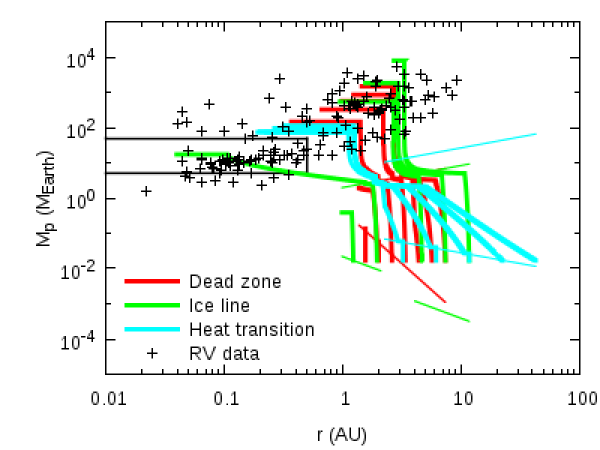Research Gallery > Planetary Sciences
Research Gallery
Planetary Sciences
| Planet traps and the population of exoplanetary systems |
|
Image Credit: Hasegawa & Pudritz 2012

Evolutionary tracks of planet forming at multiple planet traps at which rapid type I planetary migration is halted. Three types of traps are considered: dead zone (red lines), ice line (green lines), and heat transition (blue lines) traps. Five to seven tracks are computed for each planet trap in order to consider planet formation over the entire disk lifetime. The radial velocity observations of exoplanets are shown in the plus signs. The end points of tracks line-up well with the observations (Adapted from Hasegawa & Pudritz 2012, ApJ, 760, 117).
|
| The recent theoretical studies on planet formation in protoplanetary disks have implied that massive planets like the Jupiter in our Solar system are likely to be formed as a consequence of rapid migration of planetary cores into specific trapping sites in protoplanetary disks. The sites are often referred to as planet traps. This paper addresses how the combination of plane traps with the standard theory of planet formation, also known as the core accretion scenario, can well reproduce the observations of exoplanets that now amount to more than 900 (the number increases to 4000 if candidates are included). The time-evolution of planets in mass and semimajor axis is computed under the action of planet traps. Our results show that, when planet traps are coupled with a model of planetary growth, the final distribution of planets in the mass-semimajor axis diagram is consistent well with the radial velocity observations of exoplanets. This arises because planetary cores, that eventually grow to gas giants, are "stored" efficiently around 1-10 AU. Following further growth of protoplanets, this "initial" distribution of the cores ends up with the so-called mass-semimajor axis relation which shows that the (upper) planetary mass is an increasing function of semimajor axis. |
 asiaa.sinica.edu.tw Media Request: epo
asiaa.sinica.edu.tw Media Request: epo asiaa.sinica.edu.tw
asiaa.sinica.edu.tw 
